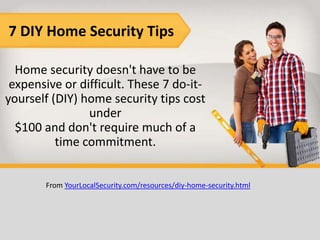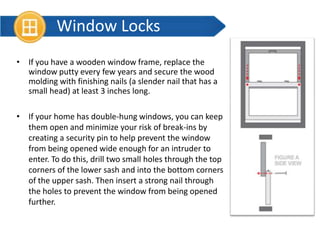DIY Home Security
- 1. 7 DIY Home Security Tips Home security doesn't have to be expensive or difficult. These 7 do-it- yourself (DIY) home security tips cost under $100 and don't require much of a time commitment. From YourLocalSecurity.com/resources/diy-home-security.html
- 2. Window Locks Windows, especially those on the back side of a home, are one of the most common entry points for burglars. Securing the windows in your home with durable locks, including backup stops, can help prevent burglars who are looking for a quick entry. Here are a few things you can do to help make your windows more secure.
- 3. Window Locks âĒ If you have a wooden window frame, replace the window putty every few years and secure the wood molding with finishing nails (a slender nail that has a small head) at least 3 inches long. âĒ If your home has double-hung windows, you can keep them open and minimize your risk of break-ins by creating a security pin to help prevent the window from being opened wide enough for an intruder to enter. To do this, drill two small holes through the top corners of the lower sash and into the bottom corners of the upper sash. Then insert a strong nail through the holes to prevent the window from being opened further.
- 4. Window Locks âĒ If your home has horizontal sliding windows, restrict outside access by placing a thick wooden dowel or metal pipe between the sash and the window frame.
- 5. Heavy-Duty Strike Plates The strike plate is the metal plate that surrounds the lockset on a door. It's set in the door jamb and receives the bolt of a lock, keeping the door in place. Because standard door moldings and deadbolt locks are rather easy for burglars to kick in, installing heavy-duty strike plates will help increase your home's security. So here is an easy guide to installing heavy-duty strike plates and making your doors more secure.
- 6. Heavy-Duty Strike Plates âĒ Purchase a 4-screw, heavy-duty strike plate from your local hardware store. Make sure the screws are at least 3 inches long. âĒ To install your new strike plate, mark the location where the plate will go. If a bolt hole does not already exist, close the door and mark where the hole should be drilled in the door jamb. If you are simply upgrading your current strike plate a bolt hole should already exist, and you'll only need to mark an outline where the new strike plate will be installed in the door jamb.
- 7. Heavy-Duty Strike Plates âĒ When drilling a new bolt hole, use a drill bit that is as wide as the bolt and make sure the hole goes deep enough to receive the full length of the bolt, when the door is locked. âĒ Next, line up the new strike plate on the door jamb and create an outline where the mortise should be created. The mortise is the pocket that is cut into the jamb for the strike plate to fit into.
- 8. Heavy-Duty Strike Plates âĒ Using a chisel, cut out the area you have marked, ensuring it is only as deep as the strike plate is thick. An easy way to clear out the area is to make your cuts 1/4 of an inch apart and remove the excess material using a downward scraping motion. âĒ Place the strike plate into the newly formed mortise, and screw it into the door jamb. Note: You may have to drill guide holes for the screws before securing the strike plate to the jamb to avoid any cracking or splitting of the door frame.
- 9. Sliding Glass Doors Sliding glass doors are notoriously easy for burglars to break into, even when they're locked. In fact, some burglars target homes with sliding glass doors because they're easy to open. Use the following questions to help check the safety of your sliding glass doors.
- 10. Sliding Glass Doors âĒ Do you have a secondary blocking device? Thick wooden dowels, 2x4's, and metal pipes are all good options.
- 11. Sliding Glass Doors âĒ Does the door's latch mechanism effectively secure the door to the frame or can it be easily lifted out of place? Prevent lifting by installing security devices like through-the-door pins. âĒ Are the door's sliding rollers working properly or can the door be "jiggled" out of place?
- 12. Garage Security Even though the garage is one of the most common entry points for burglars, some homeowners fail to secure their garage properly. Follow these tips to help ensure your garage is as safe as possible. âĒ Every door attached to the garage should have a deadbolt and should remain locked at all times. âĒ Pay particular attention to the door leading from the garage to your home. Treat this door like the front door and make sure it has a sturdy deadbolt.
- 13. Garage Security âĒ Close your garage door quickly when you arrive home so you don't reveal what you store in the garage. âĒ Newly purchased remotes have factory-set codes that should be changed immediately. Burglars can access these codes and will try them in new neighborhoods until they find a match.
- 14. Garage Door Emergency Release Levers Electric garage door openers are usually equipped with an emergency release lever. This lever typically has a cord hanging down that allows you to open the door manually in case of an emergency or power outage. While these emergency release levers are convenient, a savvy intruder can slide a coat-hanger or other sturdy wire between the door and the frame, hook the emergency release lever and easily open the garage door.
- 15. Garage Door Emergency Release Levers Here are a couple of things you can do to help prevent burglars from getting into your garage using the lever. âĒ Disable your emergency release lever and remove the emergency cord. They may be convenient, but can be pulled from the outside with a hanger or other device. âĒ Always lock the release lever. Some garage door openers have this as an option, but if your lever doesn't have a keyed lock, use a plastic zip tie to secure the lever to the carriage assembly.
- 16. Security Signs When you get a security system, make sure to display the sign or the sticker that comes with the system on your front lawn or in your window. Seeing a sign indicating the home is protected by an alarm monitoring company can be all it takes to deter burglars. Also, a common place for burglars to enter the home is from the back yard so they're not as likely to be seen. Having a sign or sticker on that side of the house can help discourage intruders.
- 17. Exterior Lighting Burglars are much more likely to target homes with poor lighting because it lowers their risk of being seen. Good indoor lighting can help, but the most important thing is proper exterior lighting. Follow these tips when upgrading your outdoor lighting: âĒ Ensure areas around windows, doors, and blind spots are properly lit, especially in the back of the home. âĒ Outdoor lights with motion sensors save energy and are fantastic deterrents for would-be intruders. âĒ When installing outdoor lights, make sure they are placed high enough that they can't easily be disabled by an intruder.
- 18. Exterior Lighting âĒ Avoid using solar-powered lights; a test completed by Consumer Reports concluded they're too dim to provide adequate security.
- 19. Exterior Lighting âĒ Compact fluorescent light bulbs are good options for outdoor lighting. They outlast other light bulbs and save energy.


















